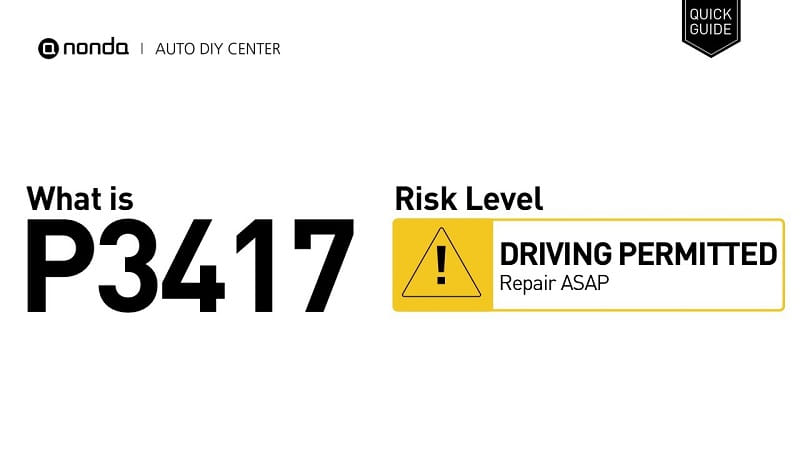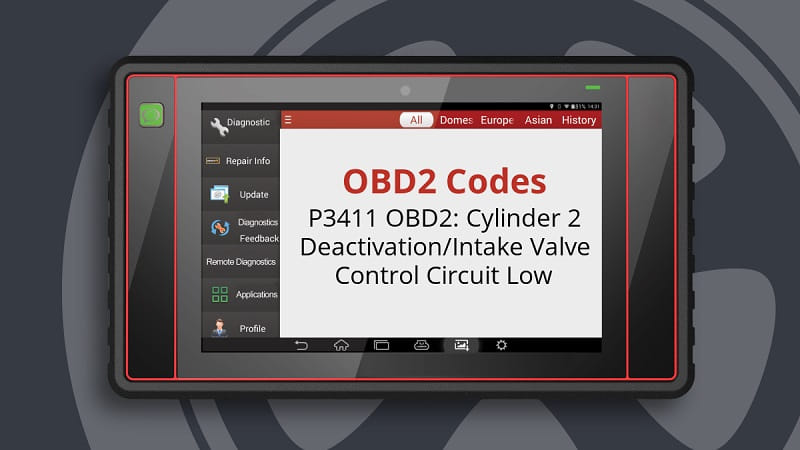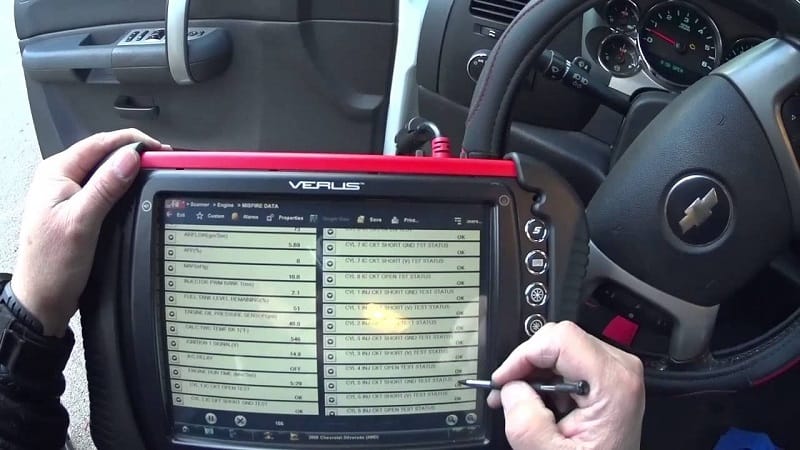This post contains affiliate links. This means I will make a commission at no extra cost to you should you click through and make a purchase [ “As an Amazon Associate, I earn from qualifying purchases.” ]. Read the full disclosure here.
Understanding Diagnostic Trouble Code P3417 Cylinder 3 Deactivation/Intake Valve Control Circuit/Open GuideMechanic.Com Modern internal combustion engines are increasingly reliant on computer-controlled systems to enhance performance, improve fuel economy, and reduce emissions.
Among the most prominent of these systems is cylinder deactivation, which temporarily shuts down specific cylinders during light engine loads to conserve fuel.
This system is closely linked to Variable Valve Timing (VVT) and relies on electronic actuators and solenoids to control intake and exhaust valve operation.
When a fault occurs within these systems, the Powertrain Control Module (PCM) stores a Diagnostic Trouble Code (DTC) to alert the driver or technician to the issue.
One such code is P3417 – Cylinder 3 Deactivation/Intake Valve Control Circuit/Open. This article will explain the code in detail, including its meaning, symptoms, causes, diagnosis, and repair procedures.
See Also: P007E Charge Air Cooler Temperature Sensor Circuit Intermittent/Erratic Bank 1
P3417 Cylinder 3 Deactivation/Intake Valve Control Circuit/Open
What Does Code P3417 Mean?

P3417 is defined as:
“Cylinder 3 Deactivation/Intake Valve Control Circuit/Open.”
This code indicates that the PCM has detected an open electrical circuit in the control system that manages the intake valve deactivation for cylinder 3.
In engines with cylinder deactivation systems—such as General Motors’ Active Fuel Management (AFM) or Honda’s Variable Cylinder Management (VCM)—the PCM controls whether an intake valve opens or remains closed by using a special solenoid-controlled actuator.
When the PCM attempts to activate or deactivate the intake valve for cylinder 3 and receives no signal return (i.e., an open circuit condition), it stores the P3417 code.
This malfunction prevents the proper operation of cylinder deactivation, which can reduce fuel efficiency and lead to other performance issues.
How Cylinder Deactivation Works
Before diving deeper into the implications of this code, it’s helpful to understand how cylinder deactivation operates.
Under low engine load, the PCM shuts off fuel injectors and deactivates intake and exhaust valves for specific cylinders.
This reduces pumping losses and conserves fuel by turning the engine into a smaller displacement engine temporarily.
To deactivate a valve, the PCM sends a signal to a solenoid, which controls an oil circuit that locks or unlocks the valve lifter mechanism.
When this process is disrupted—such as by an open circuit in the solenoid control wiring—the cylinder cannot be properly deactivated, and a DTC like P3417 is generated.
P3417 Cylinder 3 Deactivation/Intake Valve Control Circuit/Open

Common Symptoms of P3417
The symptoms of P3417 can range from mild to moderate, depending on the nature and duration of the malfunction. Some of the most common signs include:
Check Engine Light (CEL)
The most common and immediate symptom. It typically appears as soon as the PCM detects the fault.
Decreased Fuel Economy
The inability to deactivate a cylinder results in more fuel being consumed, especially at cruising speeds.
Rough Engine Idle
If cylinder deactivation is attempted but fails, the result can be an uneven idle or vibration.
Poor Engine Performance
The engine may hesitate or respond sluggishly during acceleration.
Cylinder Misfire (Occasionally)
In rare cases, the deactivation issue may trigger a misfire code for cylinder 3 (e.g., P0303).
P3417 Cylinder 3 Deactivation/Intake Valve Control Circuit/Open
What Causes Code P3417?
An “open” circuit indicates a break in electrical continuity. This could stem from a number of sources:
Faulty Cylinder 3 Intake Valve Control Solenoid
The most common cause. If the solenoid has failed internally or the coil is open, the PCM cannot complete the circuit.
Broken or Damaged Wiring
A break, corrosion, or wear in the wire harness between the PCM and the solenoid can cause an open circuit.
Disconnected or Loose Connector
Connectors may become loose over time due to vibration or improperly secured clips.
Corroded Terminals or Pins
Water intrusion or oxidation can corrode electrical terminals, impeding current flow.
Faulty PCM (Rare)
In rare instances, the PCM itself may be damaged or have an internal fault.
Oil Contamination of Electrical Components
Leaking engine oil can seep into solenoid connectors, increasing resistance or breaking the circuit.
P3417 Cylinder 3 Deactivation/Intake Valve Control Circuit/Open
How to Diagnose Code P3417

Diagnosing P3417 requires both visual and electrical inspection. Here’s a step-by-step process:
1. Retrieve the Code
Connect a professional OBD-II scanner to verify that P3417 is the only code present.
Look for related codes such as P0303 (misfire), oil pressure codes, or other cylinder deactivation faults.
2. Visual Inspection
Inspect the wiring harness and connectors related to cylinder 3’s intake valve control solenoid.
Check for broken, frayed, pinched, or oil-contaminated wires and connections.
3. Check Solenoid Resistance
Disconnect the solenoid and measure resistance across its terminals using a digital multimeter.
Typical resistance ranges between 8–15 ohms. If resistance is infinite or zero, the solenoid is likely open or shorted.
4. Perform Continuity Test
Use the multimeter to verify continuity between the solenoid connector and the PCM.
An open in this circuit confirms a break in the wiring.
5. Check for Voltage Supply
With the ignition on, test for voltage at the solenoid connector.
If voltage is absent, trace upstream to determine if the PCM is supplying power as expected.
P3417 Cylinder 3 Deactivation/Intake Valve Control Circuit/Open
How to Fix Code P3417
Once the root cause of the open circuit is found, appropriate repairs can be made:
Replace the Cylinder 3 Intake Valve Control Solenoid
If the solenoid is faulty or has an open coil, replace it with a new OEM or equivalent part.
Repair or Replace Damaged Wiring
Fix any breaks or worn sections in the harness, and ensure the wiring is properly routed and secured.
Clean or Replace Electrical Connectors
If corrosion is found, clean terminals with electrical contact cleaner or replace the connector entirely.
Secure or Reconnect Loose Connectors
Make sure all connectors are fully seated and locked into place.
Replace PCM (Rare Cases)
If all components test properly and the circuit is intact, but the PCM does not function correctly, it may need reprogramming or replacement.
P3417 Cylinder 3 Deactivation/Intake Valve Control Circuit/Open
Prevention Tips for P3417
To reduce the likelihood of this code appearing again in the future:
Maintain Engine Oil
Dirty or old oil can clog valve lifters and solenoids. Change oil and filters regularly using manufacturer-specified products.
Inspect Wiring Periodically
During routine service, check the condition of wiring and connectors.
Protect Against Moisture and Oil Leaks
Keep engine bay components dry and fix oil leaks early to prevent contamination of electrical parts.
Avoid Aftermarket Tampering
Improper installation of aftermarket devices can interfere with control circuits.
P3417 Cylinder 3 Deactivation/Intake Valve Control Circuit/Open
Is It Safe to Drive with Code P3417?
While the vehicle may continue to operate with code P3417 active, it’s not advisable to drive for extended periods without addressing the issue. Here’s why:
- Increased Fuel Consumption: The engine won’t deactivate cylinders as intended.
- Engine Wear: Misfires or improper valve operation can cause long-term engine damage.
- Catalytic Converter Damage: If misfires occur, raw fuel may reach the exhaust system.
- It’s best to address the issue promptly to restore performance and efficiency.
Conclusion
DTC P3417 signals an open circuit in the cylinder 3 intake valve control circuit, preventing proper cylinder deactivation.
The issue is most often electrical in nature—whether a faulty solenoid, damaged wiring, or connector failure. Left unresolved, this problem can reduce fuel efficiency and degrade overall engine performance.
Fortunately, with a structured diagnostic approach and proper repairs, P3417 can be resolved effectively. Preventive care, including routine inspections and oil changes, can help avoid recurrence and ensure your engine runs smoothly for years to come.
- 4×4 Truck for Sale Used - October 21, 2025
- 4×4 Truck for Sale Under 20K - October 15, 2025
- 4×4 Truck for Sale QLD - October 12, 2025
